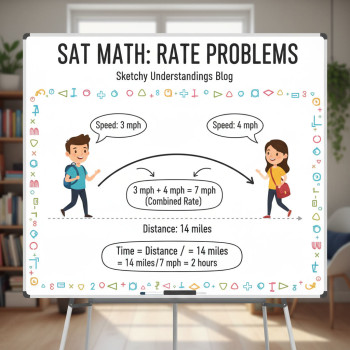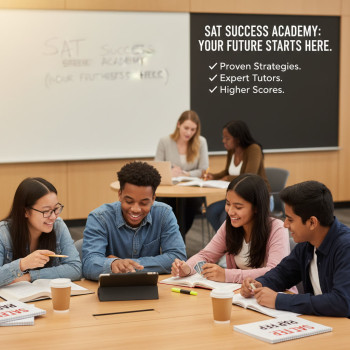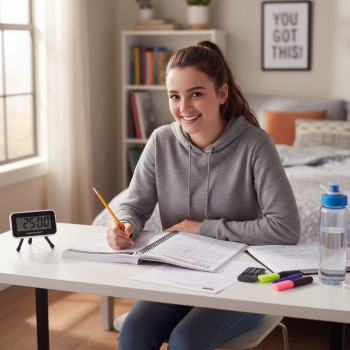Why confidence matters more than you think for the Digital SAT
When students talk about improving their SAT scores, they usually focus on content—vocabulary lists, math formulas, grammar rules. Those things matter. But there’s another player in the room that’s quietly steering many practice-test results: confidence. Confidence doesn’t magically add right answers to your paper, but it changes what you do in a test moment—how you read, whether you guess, how you respond to a tough question—and those small choices add up to real score changes.
This post unpacks the role of confidence in Digital SAT practice scores. I’ll explain why confidence influences performance, walk you through activities that build the right kind of confidence (not fake bravado), give examples and a simple data table you can use to track progress, and offer a practical, week-by-week plan you can follow. When it fits, I’ll also mention how Sparkl’s personalized tutoring and AI-driven insights can support the process—without making this post an ad. Think of this as a coach’s playbook: clear, human, and practical.
What confidence actually does during a practice test
Confidence affects three key test behaviors that change outcomes:
- Decision-making speed: Confident students make more decisive moves—finishing questions without wasted re-checking and using time more effectively.
- Risk management: Confidence influences whether you skip, guess, or overwork a question. The right balance reduces costly second-guessing.
- Error detection: Confident students are better at noticing careless mistakes because they’re mentally present rather than stuck in self-doubt.
Those behaviors are especially relevant for the Digital SAT, where timing, adaptive sections, and the testing app tools (like Mark for Review) reward focused, practical approaches to each question. Practicing with those tools while tracking your confidence creates a feedback loop that improves both skill and self-trust. (Tip: use official practice in Bluebook and the Student Question Bank when possible to match test conditions.) ([satsuite.collegeboard.org]( difference between confidence and overconfidence
Confidence and overconfidence are cousins but not identical. Real, productive confidence is built on competence—specific, repeatable skills you can demonstrate under pressure. Overconfidence is broad, vague assurance that can hide gaps. Your goal is steady, evidence-based confidence: the feeling you get when a practice score and your process agree.
Here’s how to tell them apart in practice:
- Evidence-based confidence: You predicted 70% correct on a section and scored around there; you can explain where you lost points and how to fix it.
- Overconfidence: You predicted a great score but can’t point to consistent problem areas or repeat the performance on a second practice test.
One practical activity to develop evidence-based confidence is the “Confidence Check”—rate each question as you answer it (e.g., 90%, 60%, 20%) and compare ratings to actual correctness. You’ll start to see patterns: where confidence aligns with truth and where it doesn’t. The College Board suggests similar confidence-building exercises and second-guess prevention strategies for the SAT. ([satsuite.collegeboard.org]( example: confidence in action
Imagine two students, Lila and Mark, both working on a 20-question Reading & Writing mini section in Bluebook.
- Lila takes each question, marks a confidence score, and moves on if she’s reasonably sure. She flags a few for review but doesn’t change answers impulsively. When she checks, she got 16/20 and noticed three careless punctuation errors she can fix by slowing for those question types.
- Mark feels unsure on many items. He spends extra time rereading every answer, changes five answers on a hunch, and finishes with 14/20. Two of the changes were wrong; he’d have scored higher had he trusted his first instincts more often.
Behavioral differences—decisiveness, error-awareness, and response to uncertainty—explain the gap. Those behaviors are trainable. A structure of deliberate practice + confidence tracking produces steady gains.
Simple data table to track confidence and practice performance
Use this table weekly to capture how confidence aligns with accuracy. Track one section per row (e.g., Math – Heart of Algebra) for a complete practice test session.
| Week | Section | Predicted % Correct | Actual % Correct | Avg Confidence Rating (0–100) | Notes / Action |
|---|---|---|---|---|---|
| 1 | Math – Heart of Algebra | 65 | 60 | 62 | Slow down on multi-step equations; practice 10 items. |
| 1 | Reading | 70 | 75 | 68 | Confidence slightly underestimates performance—trust instincts more. |
Over several weeks, you’ll want to see predicted and actual percentages move closer together while average confidence becomes a reliable predictor of accuracy. If confidence consistently exceeds actual performance, dial back and target core skill practice; if confidence is too low compared to performance, work on mindset and test-simulation exposure.
Practical strategies to build confidence for practice tests
Below are targeted activities that combine skill work with confidence-building. The aim is to create repeatable routines that transform nervousness into focused performance.
1) Practice with prediction (Confidence Check)
Before you check answers on a practice set, predict how many you’ll get right and rate each question’s confidence. Compare results and write two quick takeaways: one skill to reinforce and one test-taking habit to change.
2) Use timed mini-sessions
Full-length tests are valuable, but mini-sessions (20–40 minutes) let you practice decision-making and build confidence on specific question types without burning out. They’re especially useful for the adaptive Digital SAT, where you’ll want to calibrate pacing across sections. Practice in Bluebook when possible to simulate the test interface and tools. ([satsuite.collegeboard.org]( Shallow error analysis
After a practice block, categorize mistakes into: careless, content, strategy, or timing. The quickest confidence wins come from fixing careless errors (check arithmetic, punctuation, trapezoid misreads). When those disappear, your score often jumps with the same content knowledge.
4) The “Second-Guess Stopper”
If you change answers frequently, set a simple rule before testing (e.g., allow one answer change per 10 questions or wait at least 2 minutes before revisiting a question). Mark flagged items for review and stick to a decision budget. College Board practice guidance includes this exact type of exercise to reduce harmful second-guessing. ([satsuite.collegeboard.org]( Practice with a trusted coach or tutor
Having someone guide you—especially for targeted skill gaps—accelerates both competence and confidence. Personalized tutoring, like what Sparkl offers, pairs 1-on-1 guidance with tailored study plans and AI-driven insights so your practice focuses on the high-impact things. The real benefit: a tutor helps you interpret your confidence data and turn it into smarter practice sessions.
Weekly plan: 8-week program to build confidence and raise practice scores
This plan blends content, habits, and confidence metrics. It assumes 6–8 hours per week of focused practice (adjust to your schedule). Weeks 1–4 target foundation and habits; Weeks 5–8 target performance and refinement.
Weeks 1–2: Baseline and habit formation
- Take one full digital practice test in Bluebook under realistic conditions. Record predicted vs. actual and average confidence per section. ([satsuite.collegeboard.org](
- Begin daily 30–45 minute mini-sessions: 20 minutes of targeted practice + 10 minutes of shallow error analysis.
- Start the Confidence Check: rate each practice question and log predictions.
Weeks 3–4: Targeted skill work + second-guess control
- Identify two recurring problem areas and practice them intensively (10–20 focused questions daily).
- Implement the Second-Guess Stopper rule. Track how many changed answers improved or hurt your score.
- Take one timed full-section practice each week (e.g., one full Math or Reading & Writing section).
Weeks 5–6: Simulation and strategy tuning
- Do two full Bluebook practice tests under test-like conditions. Compare week-by-week data table entries.
- Refine timing and marking strategies: use Mark for Review in Bluebook to practice strategic skipping and targeted revisits. ([satsuite.collegeboard.org](
- If available, work with a tutor for a 1-on-1 review session to convert patterns into a plan; this is where Sparkl’s tailored study plans and expert tutors can turn your confidence data into a laser-focused plan.
Weeks 7–8: Peak practice and reflection
- Take two practice tests in the final two weeks, one early and one in the test-like slot to simulate test-day timing and conditions.
- Perform a final confidence vs. accuracy comparison and write a 1–page action plan for test day: pacing, which question types to slow down on, and confidence cues that tell you to trust your instincts.
Measuring progress: what counts as a win?
Wins aren’t only raw score jumps. Track these measurable outcomes:
- Higher alignment between predicted and actual percent-correct (prediction error shrinks).
- Lower rate of harmful answer changes (fewer changed answers that become wrong).
- Reduced careless-error frequency per section.
- Higher average confidence ratings that correlate with improved accuracy.
If you see consistent movement on these metrics over multiple practice tests, your confidence work is paying off—even if your score improves slowly. Confidence is the engine that lets your skill improvements show up where they matter: on timed practice and test day.
Common stumbling blocks and quick fixes
Stumbling block: False confidence
If you consistently predict higher than your results, you’ve got false confidence. Fix: return to focused content work, use targeted practice questions, and lower the stakes of timed practice until the accuracy improves.
Stumbling block: Chronic second-guessing
Fix: enforce the Second-Guess Stopper and use a marking system so you can revisit flagged items only after finishing the section. Practice this on mini-sessions first.
Stumbling block: Test-day jitter
Fix: practice under test-like conditions and build a short pre-test routine (deep breaths, simple warm-up questions, review of pacing plan). Familiarity reduces surprise and raises confidence.
How a tutor or personalized program accelerates confidence-building
Working with an experienced tutor speeds the confidence loop in two ways: targeted skill fixing and external feedback. A tutor spots patterns you miss—why your confidence mismatches reality—and gives a plan to correct it. Programs that combine 1-on-1 guidance with AI-driven insights turn your practice logs into prioritized practice tasks, saving time and reducing uncertainty. For students who have trouble translating practice results into a concrete plan, personalized tutoring—like Sparkl’s approach—bridges that gap by providing tailored study plans, expert tutors, and tools to interpret confidence data effectively.
Putting it together: an example four-week snapshot
Here’s a plausible four-week snapshot for a student aiming to improve practice scores by 30–60 points through confidence and habit work.
| Week | Key Focus | Primary Activity | Confidence Metric Target |
|---|---|---|---|
| 1 | Baseline & Predictions | 1 full Bluebook test + daily 30-min mini-sessions | Record baseline prediction error; start Confidence Check |
| 2 | Fix careless errors | Shallow error analysis + 2 targeted practice sets/day | Reduce careless errors by 25% |
| 3 | Second-guess control | Implement Second-Guess Stopper + full section timing | Decrease harmful answer changes by 50% |
| 4 | Simulation & tune | 2 full tests; tutor review session to create final 2-week plan | Prediction error shrinks; predicted vs. actual within 5–8% |
Final notes: confidence is a skill, not a trait
One of the most freeing truths about confidence is that it’s learnable. Like a math technique or passage-marking strategy, confidence is a skill you grow with targeted practice, honest reflection, and the right feedback loop. The Digital SAT rewards clear decisions, efficient pacing, and accurate self-appraisal—skills you can cultivate.
If you’re overwhelmed about where to start or how to interpret your practice data, working with a tutor or a personalized program can help you accelerate progress. Sparkl’s combination of 1-on-1 guidance, tailored study plans, and AI-driven insights is a natural fit for students who want both the human coaching and the analytical feedback to make confidence measurable and repeatable.
Quick checklist: start building confidence today
- Take a full Bluebook practice test and record predicted vs. actual performance. ([satsuite.collegeboard.org](
- Use the Confidence Check for every practice question for one week.
- Adopt a Second-Guess Stopper rule and enforce it for all timed practice.
- Fix careless errors first—those wins are fast and motivating.
- Consider a short tutor cycle (3–6 sessions) to translate patterns into a tailored plan—especially if you’re juggling schoolwork or need focused accountability.
Closing thought
Getting better at the Digital SAT is a mix of content, strategy, and trust. Confidence is the bridge between knowledge and performance. With a few disciplined habits—prediction, targeted practice, honest error analysis, and occasional expert feedback—you’ll not only raise your practice-test scores, you’ll walk into test day calmer and more in control. That steadier presence is the kind of advantage that looks small on paper but counts for real points where it matters.
If you want, I can generate a printable confidence-tracking sheet, a week-by-week study calendar customized to your current score and availability, or a short set of prompts to use with a tutor. Which would be most helpful to you right now?















No Comments
Leave a comment Cancel